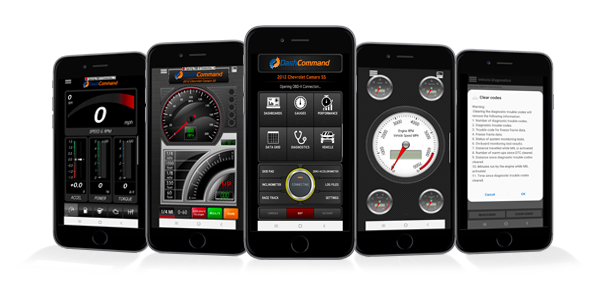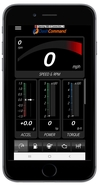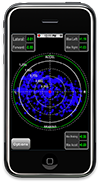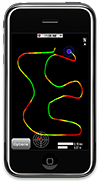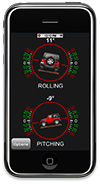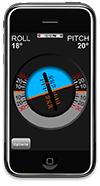Wish I read this before I bought crap Gauges for the old car 
Gauge FAQ
Who are the major gauge manufacturers?
www.omoriusa.com
www.prosportgauges.com
www.autometer.com
www.nippon-seiki.co.jp (Defi and STi Genome manufacturer)
www.daddysscp.com
www.greddy.com
www.autometer.com
www.meganracing.com
www.blitz-performance.com
www.apexi-usa.com
www.hksusa.com
www.vdo.com
www.stri-racing.com
www.stewartwarner.com
www.aempower.com
Lamco (Subaru OEM manfucturer) does not have a website
Please note that there are more gauge manufacturers and this listing contains only the most talked about gauges on NASIOC.
Who makes the best gauges? There is no best gauge manufacturer. Times change, but currently and historically the most popular manufacturers are Autometer, Defi, STi Genome, Prosport, Omori, and MadDad.
What gauges should I have? That is the question of the century with no real answer. We will discuss the following theories though:
On an unmodified vehicle no gauges are needed. This is a fairly safe statement. If more gauges were truly needed, they would be supplied by the factory as original equipment. If one would like to argue this point, you are more than welcome to argue this with SOA or Fuji Heavy Industries to your heart’s content.
For a turbocharged car, the must have gauge is the turbo boost. For a singular mounting, the OEM position of on the steering column is considered the easiest and most discrete location. Why this gauge? Even on an unmodified vehicle, there have been discoveries by owners who have installed this gauge that they are not seeing stock target boost levels. The only way to see if your car is hitting target boost is through this gauge. While there is no danger in less boost, most would want at least the OEM target levels thank you very much.
What three gauges? This is generally the #1 gauge question due to the popular A pillar gauge pod or the factory clock gauge pod that hold three gauges. The correct answer is there is no correct answer, but the most popularly used gauges are: Boost, Exhaust Gas Temperature (EGT), and Oil Pressure.
Why these three?
Boost: 100% of engine management systems including the stock one have target boost levels. The only way of ensuring you meet and not exceed these levels is with this gauge. It is considered by most to be the #1 gauge for function and ease of installation. The boost is read off of a tap in the bypass valve line and no other location.
EGT: Monitors your exhaust temperature. This gives you a relative indication of A/F ratio and knock/detonation threshold. When used correctly, this can give you can indication when its time to back off of aggressive driving. Mind you, this gauge is not to be considered an A/F or detonation monitoring device as there is no direct means of conversion. EGT should be measured via tapping into the #4 runner of the exhaust manifold and no other location.
Oil Pressure: The main consideration for oil in a motor is a loss of oil, of which this gauge gives you a relative indication. Yes, oil can be too hot or cold, but neither condition will lock up your motor; loss of oil can. Mind you, this gauge is not to be a replacement for checking your oil level as pressure does not equate to oil level on a one for one basis. Oil pressure may be read from either a gallery plug or a sandwich adapter.
What are the other gauges available or to consider?
Clock: Yes, a clock. Since the OEM clock is often deleted due a dash housing that replaces it, a clock gauge is an option for replacement.
Coolant Temperature: Yes, there is an OEM idiot gauge for this function, but the OEM unit is designed to be heavily dampened which leads to sluggish movement and slow response. They also only supply a general indication. This means that when you notice you are hot, you have no idea exactly how hot your car is or how long it took to get to that state. Aftermarket units tell you the exact temperature and many gauges feature warning lights or buzzers set by the end user as a true warning. Keep in mind that temperature probe placement plays a role as a probe placed after the thermostat will only see correct coolant temperatures after the approximate 15 minutes it takes for the thermostat to open and coolant to fully flow within the system.
Oil Temperature: Why is this important? Oil has a sweet spot. Oil works best over a narrow temperature range of 220º to 260º F. Above 285º F motor oiloxidizes and begins to turn to varnish. Below 220º F, oil is too cool to boil off trapped/suspended water and excess fuel. Another rule of thumb is that oil temps should be about 50 to 60º F hotter than coolant temperatures. This is why the generally preferred method of cooling oil is to employ an oil to coolant heat exchanger because it has the added benefit of warming the oil when cold.
Fuel Pressure: Shows how much fuel pressure is headed towards your stock or aftermarket fuel rails. This is critical for people who have an adjustable or modified fuel pressure regulator.
Voltage: Shows you the voltage your electrical system is producing.
Air/Fuel Ratio: We have two types here that need discussion.
A true A/F ratio gauge is used with a dedicated wideband oxygen sensor to provide A/F ratio data for tuning purposes. This gauge provides tuning support via quantitative A/F data. These are generally sold as sensor/gauge packages in the neighborhood of $300. Wideband systems are sometimes called"UEGO" for Universal Exhaust Gas Oxygen. The purpose behind this unit is to accurately determine the ratio of air vs. fuel. The reason this is important is for tuning purposes as a leaner mixture, to a point, creates more power than a richer mixture. Various tuners use various proportions though as this is not a how to guide on tuning. Its basic purpose is to allow the tuner to ensure the mixture is neither too rich nor too lean as both cause issues with EGT and/or detonation.
The other type is a unit designed to be wired into the factory oxygen sensor. The factory oxygen sensor is not a wideband unit that can be used for tuning. An A/F gauge that is wired into the factory sensor provides pretty lights that are 100% meaningless to air, fuel, or how much change is in your ashtray. So, if you have an empty slot in your three gauge unit that you would like filled, go for the clock gauge as it actually has a function and purpose. Seriously, this is a useless gauge.
What type of gauge should I get, mechanical or electrical?
Mechanical Gauges:
Mechanical gauges do not require power to operate.
They can use power for lighting purposes though.
They make direct physical contact with the item they are reading.
Mechanical gauges can have noise to them. Some might have a slight rattle as there are moveable gears, pins, or pivot points inside which may cause noise.
Can have a jumpy or have an erratic sweep.
Generally less expensive.
Electrical Gauges:
No large connectors and tubing coming out the back.
Can be mounted in more unusual positions without connections showing.
Easier to install in tight areas.
Easier to install a great distance from the item being measured.
Stops fluids from entering the passenger compartment.
The pointer sweep is more smooth and seamless.
Generally more expensive.
Which is more accurate though? For 99% of users either will work just fine. In theory, there is a slight advantage towards mechanical gauges, but recent electronic advances have narrowed the accuracy to the point where it is really a moot issue.
Any gauge dangers? Under no circumstances should you use a mechanical gauge inside your passenger compartment that measures flammable fluids such as oil or fuel. Boost is 100% fine, but anything with fluids just doesn’t make sense.
Where do I mount my gauges? That depends on you. There are many solutions for the different size and type gauges, some out in the open, some stealthier than others. The popular mounting solutions are A pillar mount, steering column mount, speedometer bezel mount, clock mount, left hand driver’s A/C duct mount, glove box mount, vent mount, and of course, custom mounting. Most mounting options require some arts and crafts skills to get to fit right though. This means that you may need to perform some sanding, double sided taping, dremeling, or other slight handyman actions in order to achieve a perfect fit.

This is an example of excessive, compulsive gauge madness. The good thing about it, is that it shows every major gauge mounting area except for the single steering column mount, the glove box mount below, and the vent mount below that.
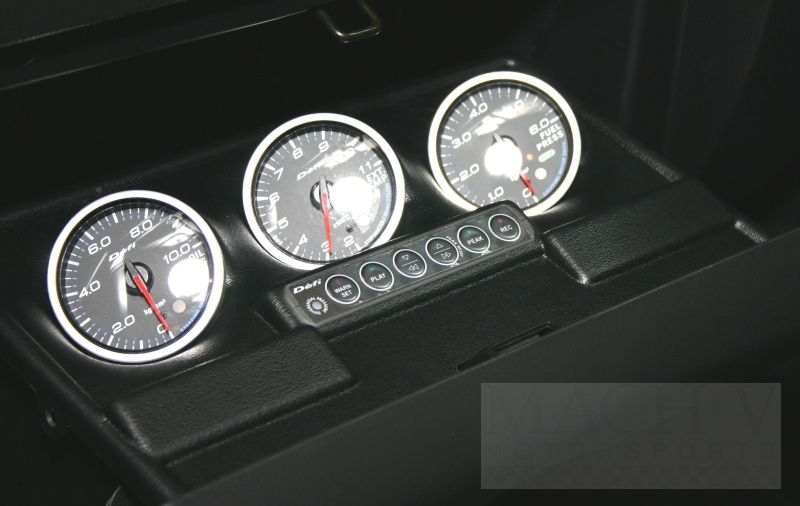

How do I convert BAR or PSI to whatever? Unit measurement is very important and should be given due consideration when gauge shopping. While having a quality JDM gauge may make you the cool kid on the block, the BAR to PSI conversion can drive you nuts. Hence the popularity of people switching from the perfectly good stock Lamco boost gauge that reads in mPa to an aftermarket PSI reading unit. The easiest way to convert these figures is to (for example) type 14.7 PSI into BAR in www.google.com and let it do the conversion for you with its built in conversion ability.
What about making my gauges dimmable? The links of interest below has some tips. It is also worth mentioning that the Subaru dimming circuit is non-standard since it is fixed positive/variable negative. Most electrical gauges are wired for the opposite, fixed negative/variable positive. This can cause problems if they are connected to the car's dimming circuit. Such gauges that share a ground for measurement and lighting must NOT be connected to the variable illumination wiring. To install such gauges so that they dim, an additional circuit is needed to "flip" the polarity of the illumination to the gauge.
What gauges match my OEM color scheme? Several manufacturers make gauges to mimic the WRX or STI color scheme, you'll have to search which manufacturers make gauges that match your interior. As well, some offer end user color adjustability that are worthy of looking into. There are ways to modify gauges to color match via new bulb condoms or by using a colored marker as well, though that takes some modification and research and is not everyone's idea of the correct way to get the gauges to look right. For really color particular people, this thread shows you how to mod your existing OEMcomponents for a 100% identical color match.
What about senders? A sender is the term for the device that actually measures the output you are looking to monitor and sends the information to thegauge face. Not all senders are created equal. Top grade senders are sometimes referred to as "VDO style" and have 2 terminals on the top for a separate and true ground. The insides are also constructed different with higher quality material and tighter tolerances. Most senders are matched to the gauge. So XXX gauges should use XXX senders. You can use a sender from a different manufacturer and it will work, but the chances that the resistance curve is the exact same is slim, in this case, the gauge will be off by varying degrees.
BSP, NPT….what does all this crap mean? British Standard Pipe Thread and National Pipe Thread. BSP is the European standard, while American stuff runs on NPT. These are terms for pipe thread types and pitch. They can be complicated, especially since they are close in sizing so that you can easily confuse a tight fitting thread with the wrong pitch thread. If you need adapters of any kind, McMaster-Carr is considered the source.
What about the famous gallery plug? It is located on the aft portion of your motor, towards the passenger side, under the intercooler. It is a half dollar sized round plug with a 5/16" female hex head. The thread size once your remove the gallery plug is 1/8 BSP. This is a common location for oil pressure or oil temperature senders.
What the heck is a sandwich adapter? It is a machined aluminum piece that goes in between your block and oil filter. It is pre-tapped to allow you to run oil pressure and oil temperature senders into it.
Which is better for my sender, gallery plug or sandwich adapter? Either works fine, though in the end the sandwich adapter is generally easier.
When I start using senders, adapters, etc., what do I use to seal it up? Three Bond 1215 or similar silicone based gasket maker, though some have used teflon tape or anti-sieze compound as substitutes.
Can I replace my OEM boost gauge but keep its look/location? Yes. Due to the unusual mPa reading of the Lamco gauge, it is a quite popular swapout. In order to do so, many will replace it with a slightly larger unit and use the same housing. Grease for lubricant and a hair dryer to soften the housing are all that are required to install an aftermarket unit as they are usually just 3mm larger than the stock gauge. It take some work to get the new unit in there correctly, but it can be done.
What are the normal gauge readings? The below listed readings are for a stock vehicle. Built motors, tuning through engine management, etc. can change these readings. As well, your gauge manufacturer, sender manufacturer, sender location, etc. can affect these readings. The best advice if your readings vary from the “norms” listed is to track your readings to find out your specific readings and record them to show cold, normal, regular, hot, high, etc. Once you have plotted your specific norms, then you can rely on them to spot problems.
Boost: 15.9 PSI max 2015+ WRX, 13.3 PSI max 2009-2014 WRX, 11.9 PSI max 2008 WRX, 11.6 PSI max 2006/2007 WRX, 13.5 PSI max 2001-2005 WRX, 14.5 PSI max STi.
Oil Pressure: 100 PSI cold, 20-40 PSI normal.
Oil Temperature: Cold = outside temperature, 220º to 260º F normal
Coolant Temperature: Cold = outside temperature, 170-200º F normal.
Fuel Pressure: 30-48 PSI normal.
EGT: 1400º F normal cruising, 1600º F during spirited runs
What about odd-ball gauge like devices? Those are entering the market at an astonishing rate these days. The main ones to come on the scene are the OBDII based units, the most famous of which being the PSI3 unit. Other units, though too numerous to mention, include the COBB AccessPORT ver. 2 with its gauge feature, TurboXS DTEC system, the Defi HUD unit, and the HKS CAMP system. We can also lump one-off units like Knock lights, the Scanmaster 4 channel EGT set-up, etc. into this category. While many of these units are worthy of consideration, this FAQ does not detail every single unique “gauge-like product” on the market though the more popular ones are listed via this question.
Links of interest:
Pics thread for gauge installs
Boost gauge install
Boost gauge install
Boost & A/F install
Oil pressure gallery plug
Oil pressure
Oil pressure sender
Oil pressure
oil pressure
Oil temp
sandwich adapter
OEM 3 gauge pod
EGT
EGT probe install
Dimming gauges
Dimming gauges
Misc gauge installation help
Gauge wiring, coloring, dimming
Editors Note
My thanks to Glenn from www.prosportgauges.com, Rich from www.daddysscp.com, and Dan from www.fastwrx.com for their input that provided a lot of the information contained within this FAQ.
This post was created because I wasn't able to find a good gauge FAQ. I came up with the text based on LOTS of searching here. Upon reading this you should have an idea of which gauges best suit your needs or not. The manufacturer is up to you.
If you find an error in this FAQ, please PM me with factual details and I will update this post. Responses such as, "I have XXX's gauge and it's great!" or "XXX's gauge broke after 1 month" are not appreciated here, that is what the Car Parts Review Forum is for.
Source - http://forums.nasioc.com/forums/showthread.php?t=1193843

Gauge FAQ
Who are the major gauge manufacturers?
www.omoriusa.com
www.prosportgauges.com
www.autometer.com
www.nippon-seiki.co.jp (Defi and STi Genome manufacturer)
www.daddysscp.com
www.greddy.com
www.autometer.com
www.meganracing.com
www.blitz-performance.com
www.apexi-usa.com
www.hksusa.com
www.vdo.com
www.stri-racing.com
www.stewartwarner.com
www.aempower.com
Lamco (Subaru OEM manfucturer) does not have a website
Please note that there are more gauge manufacturers and this listing contains only the most talked about gauges on NASIOC.
Who makes the best gauges? There is no best gauge manufacturer. Times change, but currently and historically the most popular manufacturers are Autometer, Defi, STi Genome, Prosport, Omori, and MadDad.
What gauges should I have? That is the question of the century with no real answer. We will discuss the following theories though:
On an unmodified vehicle no gauges are needed. This is a fairly safe statement. If more gauges were truly needed, they would be supplied by the factory as original equipment. If one would like to argue this point, you are more than welcome to argue this with SOA or Fuji Heavy Industries to your heart’s content.
For a turbocharged car, the must have gauge is the turbo boost. For a singular mounting, the OEM position of on the steering column is considered the easiest and most discrete location. Why this gauge? Even on an unmodified vehicle, there have been discoveries by owners who have installed this gauge that they are not seeing stock target boost levels. The only way to see if your car is hitting target boost is through this gauge. While there is no danger in less boost, most would want at least the OEM target levels thank you very much.
What three gauges? This is generally the #1 gauge question due to the popular A pillar gauge pod or the factory clock gauge pod that hold three gauges. The correct answer is there is no correct answer, but the most popularly used gauges are: Boost, Exhaust Gas Temperature (EGT), and Oil Pressure.
Why these three?
Boost: 100% of engine management systems including the stock one have target boost levels. The only way of ensuring you meet and not exceed these levels is with this gauge. It is considered by most to be the #1 gauge for function and ease of installation. The boost is read off of a tap in the bypass valve line and no other location.
EGT: Monitors your exhaust temperature. This gives you a relative indication of A/F ratio and knock/detonation threshold. When used correctly, this can give you can indication when its time to back off of aggressive driving. Mind you, this gauge is not to be considered an A/F or detonation monitoring device as there is no direct means of conversion. EGT should be measured via tapping into the #4 runner of the exhaust manifold and no other location.
Oil Pressure: The main consideration for oil in a motor is a loss of oil, of which this gauge gives you a relative indication. Yes, oil can be too hot or cold, but neither condition will lock up your motor; loss of oil can. Mind you, this gauge is not to be a replacement for checking your oil level as pressure does not equate to oil level on a one for one basis. Oil pressure may be read from either a gallery plug or a sandwich adapter.
What are the other gauges available or to consider?
Clock: Yes, a clock. Since the OEM clock is often deleted due a dash housing that replaces it, a clock gauge is an option for replacement.
Coolant Temperature: Yes, there is an OEM idiot gauge for this function, but the OEM unit is designed to be heavily dampened which leads to sluggish movement and slow response. They also only supply a general indication. This means that when you notice you are hot, you have no idea exactly how hot your car is or how long it took to get to that state. Aftermarket units tell you the exact temperature and many gauges feature warning lights or buzzers set by the end user as a true warning. Keep in mind that temperature probe placement plays a role as a probe placed after the thermostat will only see correct coolant temperatures after the approximate 15 minutes it takes for the thermostat to open and coolant to fully flow within the system.
Oil Temperature: Why is this important? Oil has a sweet spot. Oil works best over a narrow temperature range of 220º to 260º F. Above 285º F motor oiloxidizes and begins to turn to varnish. Below 220º F, oil is too cool to boil off trapped/suspended water and excess fuel. Another rule of thumb is that oil temps should be about 50 to 60º F hotter than coolant temperatures. This is why the generally preferred method of cooling oil is to employ an oil to coolant heat exchanger because it has the added benefit of warming the oil when cold.
Fuel Pressure: Shows how much fuel pressure is headed towards your stock or aftermarket fuel rails. This is critical for people who have an adjustable or modified fuel pressure regulator.
Voltage: Shows you the voltage your electrical system is producing.
Air/Fuel Ratio: We have two types here that need discussion.
A true A/F ratio gauge is used with a dedicated wideband oxygen sensor to provide A/F ratio data for tuning purposes. This gauge provides tuning support via quantitative A/F data. These are generally sold as sensor/gauge packages in the neighborhood of $300. Wideband systems are sometimes called"UEGO" for Universal Exhaust Gas Oxygen. The purpose behind this unit is to accurately determine the ratio of air vs. fuel. The reason this is important is for tuning purposes as a leaner mixture, to a point, creates more power than a richer mixture. Various tuners use various proportions though as this is not a how to guide on tuning. Its basic purpose is to allow the tuner to ensure the mixture is neither too rich nor too lean as both cause issues with EGT and/or detonation.
The other type is a unit designed to be wired into the factory oxygen sensor. The factory oxygen sensor is not a wideband unit that can be used for tuning. An A/F gauge that is wired into the factory sensor provides pretty lights that are 100% meaningless to air, fuel, or how much change is in your ashtray. So, if you have an empty slot in your three gauge unit that you would like filled, go for the clock gauge as it actually has a function and purpose. Seriously, this is a useless gauge.
What type of gauge should I get, mechanical or electrical?
Mechanical Gauges:
Mechanical gauges do not require power to operate.
They can use power for lighting purposes though.
They make direct physical contact with the item they are reading.
Mechanical gauges can have noise to them. Some might have a slight rattle as there are moveable gears, pins, or pivot points inside which may cause noise.
Can have a jumpy or have an erratic sweep.
Generally less expensive.
Electrical Gauges:
No large connectors and tubing coming out the back.
Can be mounted in more unusual positions without connections showing.
Easier to install in tight areas.
Easier to install a great distance from the item being measured.
Stops fluids from entering the passenger compartment.
The pointer sweep is more smooth and seamless.
Generally more expensive.
Which is more accurate though? For 99% of users either will work just fine. In theory, there is a slight advantage towards mechanical gauges, but recent electronic advances have narrowed the accuracy to the point where it is really a moot issue.
Any gauge dangers? Under no circumstances should you use a mechanical gauge inside your passenger compartment that measures flammable fluids such as oil or fuel. Boost is 100% fine, but anything with fluids just doesn’t make sense.
Where do I mount my gauges? That depends on you. There are many solutions for the different size and type gauges, some out in the open, some stealthier than others. The popular mounting solutions are A pillar mount, steering column mount, speedometer bezel mount, clock mount, left hand driver’s A/C duct mount, glove box mount, vent mount, and of course, custom mounting. Most mounting options require some arts and crafts skills to get to fit right though. This means that you may need to perform some sanding, double sided taping, dremeling, or other slight handyman actions in order to achieve a perfect fit.

This is an example of excessive, compulsive gauge madness. The good thing about it, is that it shows every major gauge mounting area except for the single steering column mount, the glove box mount below, and the vent mount below that.


How do I convert BAR or PSI to whatever? Unit measurement is very important and should be given due consideration when gauge shopping. While having a quality JDM gauge may make you the cool kid on the block, the BAR to PSI conversion can drive you nuts. Hence the popularity of people switching from the perfectly good stock Lamco boost gauge that reads in mPa to an aftermarket PSI reading unit. The easiest way to convert these figures is to (for example) type 14.7 PSI into BAR in www.google.com and let it do the conversion for you with its built in conversion ability.
What about making my gauges dimmable? The links of interest below has some tips. It is also worth mentioning that the Subaru dimming circuit is non-standard since it is fixed positive/variable negative. Most electrical gauges are wired for the opposite, fixed negative/variable positive. This can cause problems if they are connected to the car's dimming circuit. Such gauges that share a ground for measurement and lighting must NOT be connected to the variable illumination wiring. To install such gauges so that they dim, an additional circuit is needed to "flip" the polarity of the illumination to the gauge.
What gauges match my OEM color scheme? Several manufacturers make gauges to mimic the WRX or STI color scheme, you'll have to search which manufacturers make gauges that match your interior. As well, some offer end user color adjustability that are worthy of looking into. There are ways to modify gauges to color match via new bulb condoms or by using a colored marker as well, though that takes some modification and research and is not everyone's idea of the correct way to get the gauges to look right. For really color particular people, this thread shows you how to mod your existing OEMcomponents for a 100% identical color match.
What about senders? A sender is the term for the device that actually measures the output you are looking to monitor and sends the information to thegauge face. Not all senders are created equal. Top grade senders are sometimes referred to as "VDO style" and have 2 terminals on the top for a separate and true ground. The insides are also constructed different with higher quality material and tighter tolerances. Most senders are matched to the gauge. So XXX gauges should use XXX senders. You can use a sender from a different manufacturer and it will work, but the chances that the resistance curve is the exact same is slim, in this case, the gauge will be off by varying degrees.
BSP, NPT….what does all this crap mean? British Standard Pipe Thread and National Pipe Thread. BSP is the European standard, while American stuff runs on NPT. These are terms for pipe thread types and pitch. They can be complicated, especially since they are close in sizing so that you can easily confuse a tight fitting thread with the wrong pitch thread. If you need adapters of any kind, McMaster-Carr is considered the source.
What about the famous gallery plug? It is located on the aft portion of your motor, towards the passenger side, under the intercooler. It is a half dollar sized round plug with a 5/16" female hex head. The thread size once your remove the gallery plug is 1/8 BSP. This is a common location for oil pressure or oil temperature senders.
What the heck is a sandwich adapter? It is a machined aluminum piece that goes in between your block and oil filter. It is pre-tapped to allow you to run oil pressure and oil temperature senders into it.
Which is better for my sender, gallery plug or sandwich adapter? Either works fine, though in the end the sandwich adapter is generally easier.
When I start using senders, adapters, etc., what do I use to seal it up? Three Bond 1215 or similar silicone based gasket maker, though some have used teflon tape or anti-sieze compound as substitutes.
Can I replace my OEM boost gauge but keep its look/location? Yes. Due to the unusual mPa reading of the Lamco gauge, it is a quite popular swapout. In order to do so, many will replace it with a slightly larger unit and use the same housing. Grease for lubricant and a hair dryer to soften the housing are all that are required to install an aftermarket unit as they are usually just 3mm larger than the stock gauge. It take some work to get the new unit in there correctly, but it can be done.
What are the normal gauge readings? The below listed readings are for a stock vehicle. Built motors, tuning through engine management, etc. can change these readings. As well, your gauge manufacturer, sender manufacturer, sender location, etc. can affect these readings. The best advice if your readings vary from the “norms” listed is to track your readings to find out your specific readings and record them to show cold, normal, regular, hot, high, etc. Once you have plotted your specific norms, then you can rely on them to spot problems.
Boost: 15.9 PSI max 2015+ WRX, 13.3 PSI max 2009-2014 WRX, 11.9 PSI max 2008 WRX, 11.6 PSI max 2006/2007 WRX, 13.5 PSI max 2001-2005 WRX, 14.5 PSI max STi.
Oil Pressure: 100 PSI cold, 20-40 PSI normal.
Oil Temperature: Cold = outside temperature, 220º to 260º F normal
Coolant Temperature: Cold = outside temperature, 170-200º F normal.
Fuel Pressure: 30-48 PSI normal.
EGT: 1400º F normal cruising, 1600º F during spirited runs
What about odd-ball gauge like devices? Those are entering the market at an astonishing rate these days. The main ones to come on the scene are the OBDII based units, the most famous of which being the PSI3 unit. Other units, though too numerous to mention, include the COBB AccessPORT ver. 2 with its gauge feature, TurboXS DTEC system, the Defi HUD unit, and the HKS CAMP system. We can also lump one-off units like Knock lights, the Scanmaster 4 channel EGT set-up, etc. into this category. While many of these units are worthy of consideration, this FAQ does not detail every single unique “gauge-like product” on the market though the more popular ones are listed via this question.
Links of interest:
Pics thread for gauge installs
Boost gauge install
Boost gauge install
Boost & A/F install
Oil pressure gallery plug
Oil pressure
Oil pressure sender
Oil pressure
oil pressure
Oil temp
sandwich adapter
OEM 3 gauge pod
EGT
EGT probe install
Dimming gauges
Dimming gauges
Misc gauge installation help
Gauge wiring, coloring, dimming
Editors Note
My thanks to Glenn from www.prosportgauges.com, Rich from www.daddysscp.com, and Dan from www.fastwrx.com for their input that provided a lot of the information contained within this FAQ.
This post was created because I wasn't able to find a good gauge FAQ. I came up with the text based on LOTS of searching here. Upon reading this you should have an idea of which gauges best suit your needs or not. The manufacturer is up to you.
If you find an error in this FAQ, please PM me with factual details and I will update this post. Responses such as, "I have XXX's gauge and it's great!" or "XXX's gauge broke after 1 month" are not appreciated here, that is what the Car Parts Review Forum is for.
Source - http://forums.nasioc.com/forums/showthread.php?t=1193843















